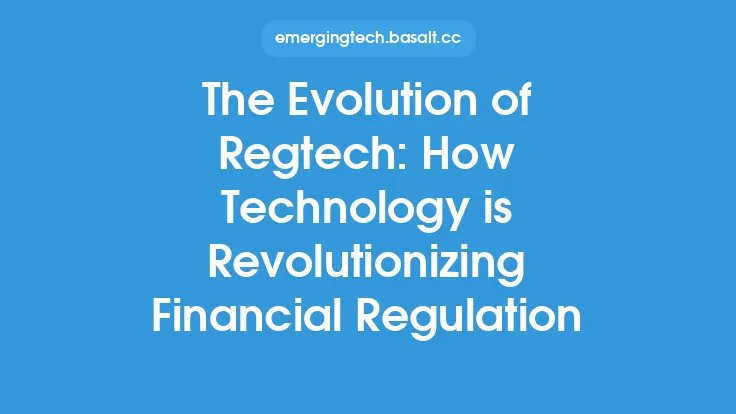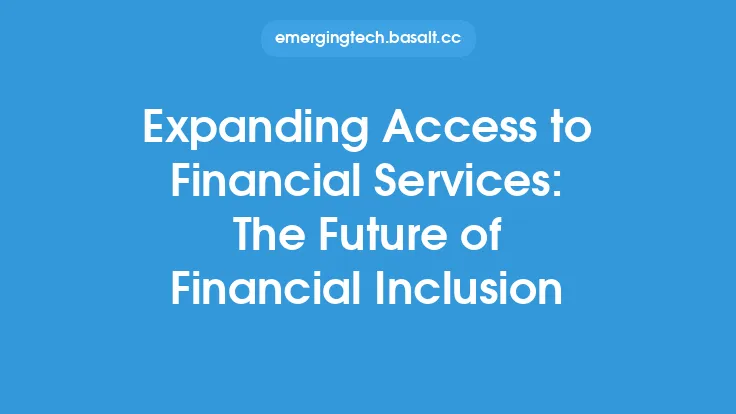The issue of financial exclusion is a pervasive problem that affects millions of people worldwide, with an estimated 1.7 billion adults remaining unbanked, according to the World Bank. This means that they lack access to basic financial services such as savings accounts, credit, and insurance, making it difficult for them to manage their finances, invest in their future, and weather financial shocks. However, the advent of fintech has brought new hope to this underserved population, offering a path to financial empowerment and inclusion.
Introduction to Fintech for the Unbanked
Fintech, short for financial technology, refers to the use of technology to improve and automate financial services. In the context of the unbanked, fintech solutions can provide access to financial services that were previously unavailable or unaffordable. These solutions can range from mobile payment systems and digital wallets to online lending platforms and microfinance institutions. By leveraging technology, fintech companies can reduce the costs and barriers associated with traditional banking, making it possible for the unbanked to access financial services that were previously out of reach.
Key Features of Fintech Solutions for the Unbanked
Fintech solutions for the unbanked typically have several key features that make them accessible and useful to this population. These include:
- Mobile-first approach: Many fintech solutions for the unbanked are designed with a mobile-first approach, recognizing that mobile phones are often the primary means of accessing the internet and financial services in developing countries.
- Digital identity verification: Fintech companies use digital identity verification methods, such as biometric authentication and machine learning algorithms, to verify the identity of customers and prevent fraud.
- Alternative credit scoring: Fintech companies use alternative credit scoring methods, such as social media data and mobile phone usage patterns, to assess the creditworthiness of customers who lack traditional credit histories.
- Low-cost transactions: Fintech solutions often have low or no transaction fees, making it possible for the unbanked to make small transactions without incurring significant costs.
Types of Fintech Solutions for the Unbanked
There are several types of fintech solutions that cater to the needs of the unbanked, including:
- Mobile payment systems: Mobile payment systems, such as M-Pesa in Kenya, allow users to store and transfer money using their mobile phones.
- Digital wallets: Digital wallets, such as PayPal and Google Wallet, allow users to store and manage their money digitally, making it possible to make online transactions and pay bills.
- Online lending platforms: Online lending platforms, such as Kiva and Zidisha, provide access to credit for individuals and small businesses that lack access to traditional banking services.
- Microfinance institutions: Microfinance institutions, such as Grameen Bank and SKS Microfinance, provide small loans and other financial services to low-income individuals and small businesses.
Benefits of Fintech for the Unbanked
The benefits of fintech for the unbanked are numerous and significant. These include:
- Increased access to financial services: Fintech solutions provide access to financial services that were previously unavailable or unaffordable, making it possible for the unbanked to manage their finances, invest in their future, and weather financial shocks.
- Improved financial inclusion: Fintech solutions can help to reduce the number of unbanked individuals, promoting financial inclusion and reducing poverty.
- Increased economic opportunities: Fintech solutions can provide access to credit and other financial services, making it possible for individuals and small businesses to invest in their future and pursue economic opportunities.
- Reduced transaction costs: Fintech solutions often have low or no transaction fees, making it possible for the unbanked to make small transactions without incurring significant costs.
Challenges and Limitations of Fintech for the Unbanked
While fintech solutions have the potential to provide significant benefits to the unbanked, there are also several challenges and limitations that must be addressed. These include:
- Regulatory frameworks: Fintech companies often operate in a regulatory gray area, making it difficult to ensure that they are complying with relevant laws and regulations.
- Infrastructure and connectivity: Fintech solutions often require reliable internet and mobile phone connectivity, which can be a challenge in developing countries where infrastructure is limited.
- Financial literacy: Fintech solutions can be complex and difficult to use, requiring a level of financial literacy that may not be present among the unbanked.
- Security and fraud: Fintech solutions can be vulnerable to security risks and fraud, making it essential to implement robust security measures to protect customers.
Future of Fintech for the Unbanked
The future of fintech for the unbanked is promising, with several trends and developments that are likely to shape the industry in the coming years. These include:
- Increased use of artificial intelligence and machine learning: Fintech companies are likely to increasingly use artificial intelligence and machine learning to improve the efficiency and effectiveness of their services.
- Growing importance of digital identity verification: Digital identity verification is likely to become increasingly important, as fintech companies seek to prevent fraud and ensure that customers are who they claim to be.
- Expansion into new markets: Fintech companies are likely to expand into new markets, including developing countries where there is a significant need for financial inclusion.
- Increasing collaboration between fintech companies and traditional banks: Fintech companies are likely to increasingly collaborate with traditional banks, recognizing that they can learn from each other and provide more comprehensive services to customers.





